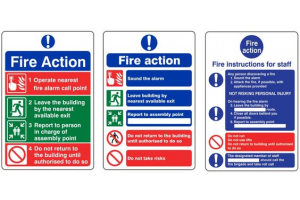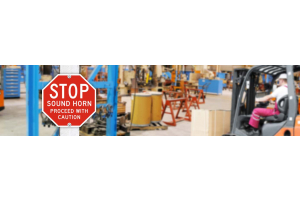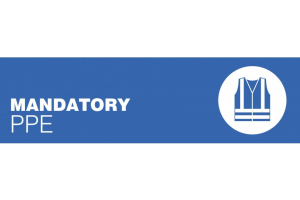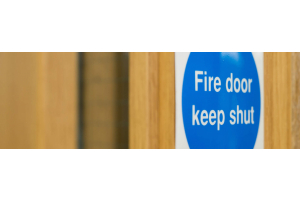
Safety sign colours explained
Do you know what is signified by green safety signs? How about the red fire signs, blue circled mandatory signs and yellow warning signs with triangles? They all form the family of safety signs which have been designed for the sole purpose of reducing risks in areas which cannot be controlled by other measures as far as reasonably practical around your workplace and to provide people with safe passages of routes in the event of an emergency, the green and white safety signs are considered safe condition signs and used for providing a safe message to others in various formats such as fire escape signs, safe operation signs, emergency assembly point signs and emergency first aid signs. Green signs are considered safe to go such as fire exit signs which convey white pictogram symbols on a vibrant green background with the white symbols being either an arrow pointing towards a specific direction and usually accompanied with a white pictogram of person running out of a door which signifies to the occupants this direction takes you along a safe, fire protected route towards either the next fire exit sign (if there is a change of direction) or towards the nearest available fire exit and eventually to a place of safety.
Green & white signage explained

Safe operation signs consist of white text and pictograms on a green background which are used for showing people how they can access or open specific doors or areas in a safe manner, we associate green as being a safe colour and it provides reassurance to people that the action on the sign is safe to be carried out such as a 'push to open' sign which can also feature a forward pointing arrow to show people that it is safe to open the door by pushing it open, fire assembly point signs also have green backgrounds and are used for mounting around workplaces to provide a designated muster point for people evacuating buildings, assembly points for fire evacuations are available in conveying numerous messages such as being numbered or having specific letters which signifies to the occupants a pre-determined muster point they need to attend and be accounted for, assembly points are safe havens so it is important they are located as far as practical from a building which may be on fire. Emergency first aid signs are also safe condition, green and white signs used for highlighting all first aid facilities, equipment and products including first aid kits.
Red & White signage explained
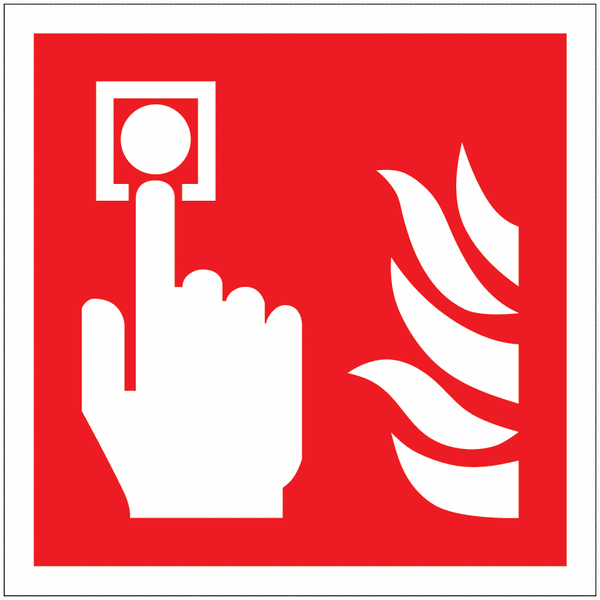
All workplaces in the UK have some form of fire fighting equipment such as fire blankets, fire extinguishers and fire hose reels, it is vital that the occupants of the building fully understand where the fire equipment can be located in the event of an emergency, business owners and managers must ensure fire equipment is fit for purpose, fully charged, clearly visible and easy to access at all times. To comply with the health & safety law and adhere to workplace regulations all business owners must provide fire signs which clearly shows fire fighting equipment locations, fire signage features a vibrant red background with white pictogram symbols and where appropriate added text which explains the type of fire fighting equipment. There are numerous formats of fire fighting signs to choose from with the most popular being the types which highlights fire extinguisher locations, the types of fires they can combat, the types of fires they cannot extinguish and can even demonstrate how to use and operate the fire extinguishers, although this is not required as most fire extinguishers features instructions on their use on the front of the vessel. Fire equipment signs can also be used in areas where fire equipment may be obscured or in recesses in walls or cupboards such as fire extinguishers and fire hose reels in corridors and common areas not normally visible to everyone, if this is the case within your premises you may benefit from fire equipment signs which project from walls or which can be suspended from ceilings so the fire equipment location can be clearly seen over larger distances and from both sides of corridors.
Blue & white signage explained
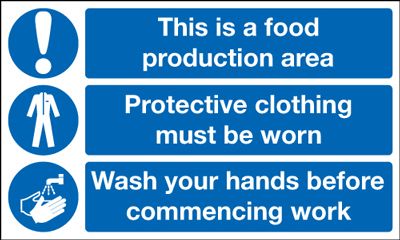
One of the most important range of workplace signs are the mandatory signage range, employers and managers of workplaces both indoors and outdoors including building and construction sites have a duty to protect their staff, visitors, contractors and where appropriate the general public from being harmed or injured whilst carrying out their daily working activities under the control of the employers workplace. Where the duties of people involve them coming into contact with dangerous activities or working practices which may cause harm then employers must take specific action to reduce or eliminate this chance, one of the ways this can be achieved is by mounting mandatory signage for example, workplaces which have load and noisy machinery and equipment running as part of their daily working processes will produce constant high noise levels which for people in the same area or location as the machinery may suffer, over time from hearing loss or tinnitus, for employers to reduce the risk of this happening to people they must mount and display the appropriate signage to make sure people wear some form of ear protection to reduce the noise levels of the machinery and equipment to a suitable level, this signage must be in the form of a mandatory sign which features a vibrant blue background with white pictogram symbols and text, blue and white signs have a mandatory meaning which means that staff working around the load machinery and equipment MUST wear ear protection to help reduce the chances of having long term hearing damage.
Yellow & black signage explained
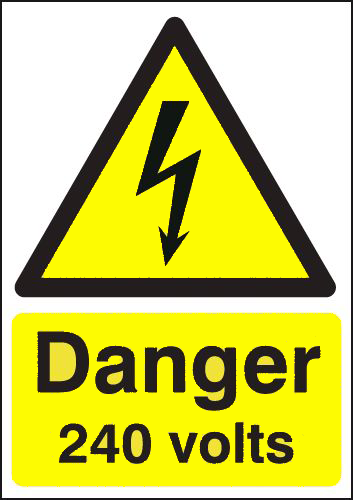
All workplaces whether indoors or out have dangers and hazards which can cause harm, injury or even death to others if not controlled in a proper and sufficient manner, by law employers must carry out a suitable and sufficient risk assessment of workplaces under their control and where the findings indicate specific hazards or dangers to others must take reasonable steps to either reduce or eliminate those hazards or dangers bringing harm, injury or even death to others. Without a doubt dangerous and hazardous areas exists in all workplaces but it takes both the employees to work together with the employer to ensure that is safety messages are put in place then for the safety of everyone the signs are observed and fully understood and if necessary training is provided. Yellow and black signage consists of a vibrant yellow background, black pictogram symbols and normally accompanied by text but does feature a black triangle commonly known as a warning triangle.
Following your risk assessment and depending on the working practices involved employers may discover dangerous areas, hazardous areas or hazards which may bring harm, injury or even death to others if not properly controlled such as hazards being reduced or eliminated. Yellow and black signs are known more commonly as hazard warning signs, you would mount and display them in areas which are dangerous or hazardous to others to ensure people fully understand what the risk of injury, harm or even death is from so preventative measure can be applied, for example in areas which have electrical hazard risks such as electrical intake rooms, boiler rooms, lift motor rooms, electrical switchboards and outdoor power generator compounds all have one thing in common in that people working in that area all have the same risk of being harmed, injured or even killed from electricity, for this reason employers must take action to warn others of the risks from electrical shocks because in the majority of cases the electrical risks cannot be removed but you can warn others of the risks from electricity before entering the area. Hazard signage are yellow and black for this reason, to highlight dangers and risks to others so they are fully aware of the dangers posed to them is specific areas which in turn is intended to reduce the possibility of them being harmed, injured or killed by the hazards.
Red & white circular signage explained
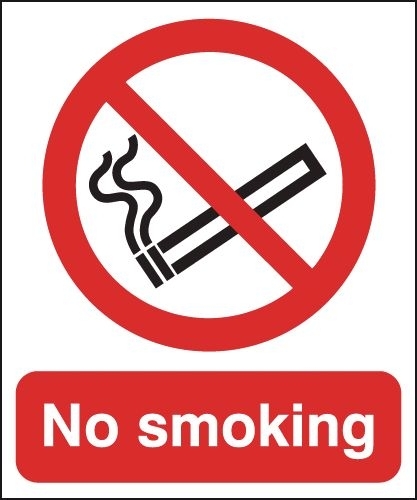
Sometimes around workplaces whether indoors or out people can carry out specific actions or activities which may cause harm or injury to themselves or others, these red and white circular signs are more commonly known as prohibition signs, business and building owners, following a risk assessment will use prohibition signage to help stop, restrict, prevent and prohibit people because their actions or activities may harm others. Prohibition signs feature a red background with where a white message is required but must be accompanied by a red circle with a diagonal red line passing through it on a white background, inside the red circle very often a black pictogram symbol is used which signifies what the message shows, the reason for using a black pictogram is that it is universally recognised, if we removed the message from the prohibition sign we could still understand what we are prohibited from doing simply by observing the black pictogram symbol. For example, if employers wants to prohibit others from smoking around their premises then the no smoking prohibition signs can be displayed, the sign clearly shows the message 'NO SMOKING' in white over a red background and we can clearly see a black burning cigarette pictogram symbol on a white background enclosed inside a red circle with a diagonal red line passing through it, now if the message was removed it would still be fully understood as a 'NO SMOKING' allowed message as the cigarette pictogram is inside a prohibition symbol which is universally recognised.
Multi-Colour signage explained
Some workplaces, generally building and construction sites pose many hazards and risks to people due to the terrain, plant, equipment and machinery being used on the sites so they hazards and dangers will be everywhere and if not controlled an accident waiting to happen. Building and construction site managers have sole responsibility for the health & safety of everyone entering their sites, whether this be the workers, sub-contractors, visitors, delivery drivers and inspectors, with this in mind controlling hazardous and dangerous areas can be difficult as the sites terrain and landscape changes on a daily basis, where one hazard was removed one day another dangerous area may be present the next, it is for this reason that for building and construction site managers to look after the health & safety of everyone on their sites everyone has a duty by law to help site managers by complying with all safety rules and regulations set out by the site managers. Multi-colour signs are more commonly know as multi-message signs, these types of signs are useful in the fact they convey a number of safety messages on one sign rather than mounting a large number of signs conveying different messages which can often lead to sign blindness which is where people will see so many signs they cannot absorb all the information, whereas a multi-message sign is one sign conveying all the messages required for the safety of themselves and others whilst on the sites.
Multi-message signage will be used by building and construction site managers to help ensure everyone entering their sites do so in a safe manner and any risks from harm or injury will be reduced by carrying out the instructions on the signs, for example a typical building and construction site safety sign might include the following;
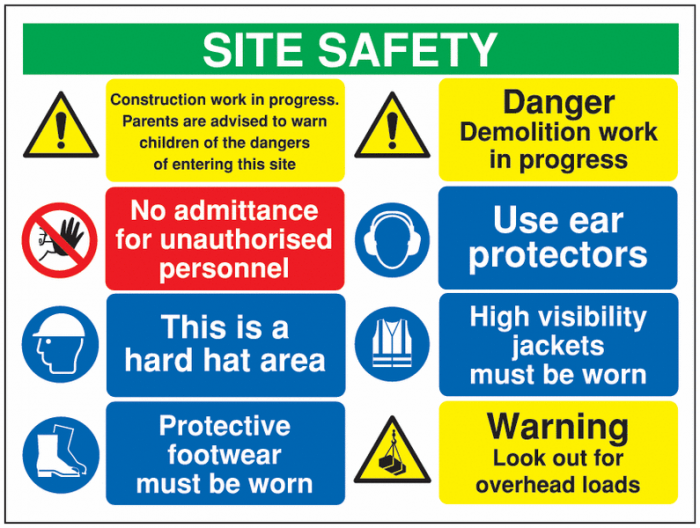
- A green and white 'SITE SAFETY' message as the heading.
- A yellow & black message warning parents to not allow their children to play on the site.
- Red & White circular message to prohibit unauthorised entry.
- A blue & white sign which makes it mandatory for head protection to be worn.
- A blue & white message sign which instructs people to wear foot protection.
- A yellow & black message sign which warns of the dangers from demolition works being carried out.
- A blue & white message sign which instructs you to wear ear protectors.
- A blue & white sign which has the message high visibility clothing must be worn.
- A yellow & black sign which warns of the dangers from overhead loads.
As you can easily see from the above safety messages, each message is unique but is needed for everyones safety, if individual signs are used for each safety messages it would require up to nine separate signs and this could cause confusion or sign blindness. As you can see from the multi-message sign the messages colours are not confusing and we can carry out the specific actions demonstrated by wearing ppe, be aware of the dangers and hazards present and understand we are not allowed entry until we are authorised to do so. All the above are essential signage for use in all workplaces, depending on the findings from your risk assessment you must decide the types of signs to use which reduces potential harm or injury to others, in some cases or where the above messages are required in numerous area safety labels can also be used.
